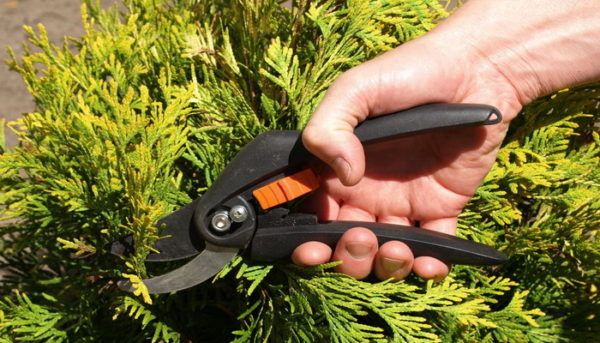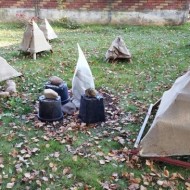How to cover a juniper for the winter and protect it from freezing
Content
Winter hazards
Juniper is a frost-resistant crop. It tolerates cold and frost normally, but under the influence of strong wind and scorching sun rays, it loses not only its decorative appearance, but can also die. The drying winter wind contributes to the rapid loss of life-giving liquid, as a result of which the branches become brittle, freeze and break off. That is why in the spring you can often find shrubs with broken off dry shoots and yellow-brown needles. Sunburn during sudden long thaws contributes to the opening of the stomata of the needles - the plant begins to breathe actively, the process of moisture evaporation is activated.
While the above-ground part is actively functioning, the roots in the unheated earth remain in a frozen state. The shrub does not have time to replenish the moisture supply and dries up. Ultraviolet light is another hazard. The sun's rays are reflected from the bright white snow and hit the tips of the needles, burning it. Also, young bushes may not withstand the thick snow stuck on the branches: the snow masses can not only break the branches, but also twist the root of the juniper.
Taking into account all possible dangers, you should take care of an adequate type of shelter that will help retain moisture, protect from wind and sun. One of the stages of preparing a juniper for winter is autumn care.
Video "Shelter of conifers for the winter"
From this video you will learn how to properly cover conifers for the winter.
Autumn work front
The active preparation of the shrub for winter begins in the fall. Before the shelter of the juniper, the necessary agrotechnical measures are carried out: water-charging irrigation, pruning, treatment from pests and diseases.
Watering and spraying
The need for watering depends on the weather: if the fall is rainy, then the plant does not need additional moisture. Otherwise, if the hot summer has turned into a mild dry autumn, it is necessary to water the juniper once every 2 weeks. For a medium-sized bush, you will need about two ten-liter buckets of water. Immediately before the shelter, 4–5 buckets of water are poured into the near-trunk zone, which is better to loosen a little.
A layer of mulch will help trap moisture and provide ventilation. Spraying has a beneficial effect on the appearance and health of the plant. To do this, you need to use settled water at room temperature. So that the shrub does not suffer from the sun's rays, which, together with moisture, can burn out the needles, the procedure is recommended to be carried out early in the morning or after sunset.
Pruning
Autumn pruning takes place in mid-November. During it, dry and damaged branches are removed. If necessary, the formation of the crown of the bush takes place in the process. However, when pruning, you should be careful: shoots grow back slowly. It is impossible to remove too much of the shrub at a time, it will not have time to recover before winter.
Protective measures
The most ardent enemies of juniper are rust and aphids.Dust and spider mites can be just as dangerous. Treatment of the shrub with the drug "Abiga-Peak" will help prevent the development of the disease and cure the plant. For a full result, you will need 4 spraying at intervals of 10 days. Insecticidal preparations "Fitoverm" and "Fufanon" perfectly cope with pests.
Shelter by the rules
After carrying out the necessary agrotechnical measures in the last decade of November, the juniper is covered. The near-trunk zone is mulched with peat, the branches are tied around the trunk. The harness will help prevent damage to branches and freezing of the trunk. You can cover the juniper with:
- Snow. A snowdrift of loose snow falls on the connected structure. It is important to ensure that the snow does not freeze and damage parts of the plant during the shelter process.
- Lapnik. Pine needles are perfectly permeable to air and moisture and at the same time protects the plant from wind, snow and sunlight.
- Burlap or non-woven fabric (agrofibre, spunbond). Part of the bush is wrapped in a special material, leaving the bottom uncovered. The film will not work for this purpose - the plant can resist under it.
- Screen. It is usually installed on the sunny side to accumulate the energy of the sun and warm the plant.
In regions with harsh winters, young animals are often dug up, placed in a container and brought into a cool room. Mature plants are insulated with a special covering material, wrapped several times, and covered with additional snow on top.
Typical mistakes
Ordinary summer residents and inexperienced gardeners often make mistakes that can become irreparable:
- Waterlogging. Abundant watering contributes to waterlogging of the soil and the development of the decay process. Root decay negatively affects the health of the entire plant.
- Improper feeding. Untimely or excessive fertilization of juniper with nitrogen-containing dressings promotes active growth of shoots, which prevents the plant's root system from accumulating the necessary nutrients for wintering.
- Improper pruning and processing of cuts with garden pitch. Excessive pruning can cause a tree to stop growing and developing. Garden varnish processing "preserves" the cut site and interferes with the emergence of young shoots.
- Use as a top dressing chicken manure or mullein.
Regional distinctive features
The need for shelter and the method depend on the climatic conditions for the growth of the plant. Juniper care in autumn and summer in different regions also has its own characteristics. In the areas of the Volga region, juniper must be protected primarily from sunburn. To do this, the plant is loosely wrapped several times with cotton cloth, burlap, tulle so that the shrub breathes. In the middle lane, the plant is most often covered with spruce branches and snow is poured on top. In Siberia and the Urals, they are wrapped with a special covering material, young trees are dug up and brought into the room.
Using these tips, you can provide the juniper with proper care, and in the spring the bush will delight the eye with the brightness of the greenery.





